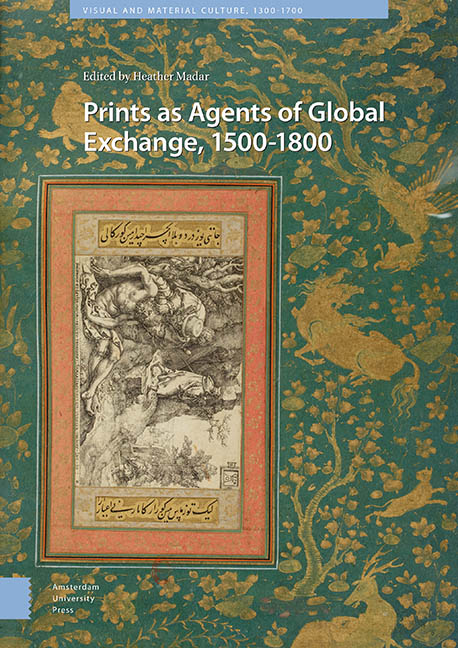Book contents
- Frontmatter
- Table of Contents
- List of illustrations
- Introduction
- 1 Concealing and Revealing the Female Body in European Prints and Mughal Paintings
- 2 The Sultan’s Face Looks East and West: European Prints and Ottoman Sultan Portraiture
- 3 From Europe to Persia and Back Again: Border-Crossing Prints and the Asymmetries of Early Modern Cultural Encounter
- 4 The Dissemination of Western European Prints Eastward: The Armenian Case
- 5 The Catholic Reformation and Japanese Hidden Christians: Books as Historical Ties
- 6 (Re)framing the Virgin of Guadalupe: The Concurrence of Early Modern Prints and Colonial Devotions in Creating the Virgin
- 7 Hidden Resemblances: Re-contextualized and Re-framed: Diego de Valadés’ Cross Cultural Exchange
- 8 The Practice of Art: Auxiliary Plastic Models and Prints in Italy, Spain, and Peru
- 9 Ink and Feathers: Prints, Printed Books, and Mexican Featherwork
- Index
5 - The Catholic Reformation and Japanese Hidden Christians: Books as Historical Ties
Published online by Cambridge University Press: 16 December 2021
- Frontmatter
- Table of Contents
- List of illustrations
- Introduction
- 1 Concealing and Revealing the Female Body in European Prints and Mughal Paintings
- 2 The Sultan’s Face Looks East and West: European Prints and Ottoman Sultan Portraiture
- 3 From Europe to Persia and Back Again: Border-Crossing Prints and the Asymmetries of Early Modern Cultural Encounter
- 4 The Dissemination of Western European Prints Eastward: The Armenian Case
- 5 The Catholic Reformation and Japanese Hidden Christians: Books as Historical Ties
- 6 (Re)framing the Virgin of Guadalupe: The Concurrence of Early Modern Prints and Colonial Devotions in Creating the Virgin
- 7 Hidden Resemblances: Re-contextualized and Re-framed: Diego de Valadés’ Cross Cultural Exchange
- 8 The Practice of Art: Auxiliary Plastic Models and Prints in Italy, Spain, and Peru
- 9 Ink and Feathers: Prints, Printed Books, and Mexican Featherwork
- Index
Summary
Abstract
The Jesuit Mission Press and its products in early modern Japan have contributed much to our understanding of how the Jesuits tried to introduce Christianity. How did Japanese novices and believers use the printed materials? One can get a good idea by analyzing the variety of adaptations of manuscripts produced by local believers from books rediscovered after being hidden for centuries by clandestine believers. Without the guidance of clergymen, some transcribed or summarized the full originals, others added and changed some words and phrases, combining important parts of more than one original, etc. They were unique adaptations of Jesuit publications for local believers to maintain their Christian practice without the guidance of clergymen that was considered indispensable among Tridentines.
Keywords: Jesuit Mission, The Christian Century in Japan, Global Renaissance, Kirishitan, Book History, History of printing
Introduction
The European printing press, brought to Japan in 1590 by the Jesuits, and the subsequent publishing activities over the next quarter-century exemplify the Global Renaissance: the worldwide effects of the European Renaissance.
The Jesuit mission press in Japan has already been extensively studied in fields including bibliography, linguistics, and Japanese literature since the early 20th century. In particular, a notable body of work has focused on the history of printing technology. For example, from around the early 21st century, computer technology has been used to examine the influence of Jesuit mission publications, Korean letterpress printing technology brought to Japan during the Japanese invasions of Korea of 1592-1598, and the letterpress technology that emerged around the same period in Japan, especially in Kyoto. Additionally, textual comparisons between publications by the Jesuit press in Japan and their original sources (i.e. European dictionaries/ grammar books or religious/catechetical books) are increasing in number.
These recent studies, mainly pursued by Japanese scholars, form part of the foundation of recent global history research and illustrate the missionary work conducted by Europeans and Japanese converts, including Japanese laypeople who were accepted into religious orders or received titles like dōjuku (or dojico, auxiliary of missionary that lived in the same residence without taking monastic vows) and kanbō (or kambo, sacristan and lay deputy of missionary).
- Type
- Chapter
- Information
- Prints as Agents of Global Exchange1500-1800, pp. 159 - 180Publisher: Amsterdam University PressPrint publication year: 2021



